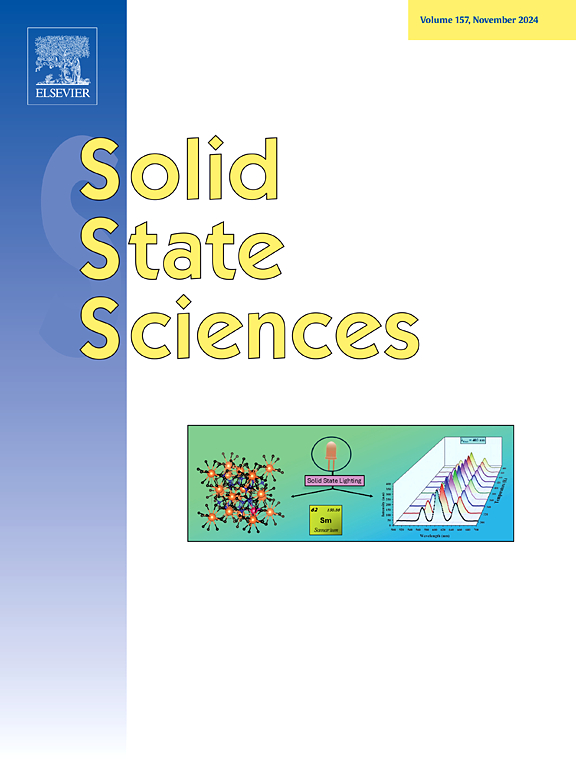多壁碳纳米管修饰BiFeO3纳米复合材料的结构、介电和磁性能及其技术应用
IF 3.4
3区 化学
Q2 CHEMISTRY, INORGANIC & NUCLEAR
引用次数: 0
摘要
在这项研究中,一种廉价的技术被称为溶胶-凝胶自燃烧法用于合成BiFeO3 (BFO)纳米颗粒。采用超声方法制备了不同重量百分比的多壁碳纳米管(MWCNTs),分别为x = 0、5、10、15和20 wt%的BFO/MWCNTs纳米复合材料。采用甲苯作为功能化剂增强分散性。采用x射线衍射(XRD)、透射电子显微镜(TEM)、拉曼光谱(Raman spectroscopy)等表征技术,以及介电性能和磁性能测量等手段对制备的纳米复合材料进行了全面分析。XRD分析证实了纳米复合材料的晶体结构。Scherrer的公式根据x射线衍射图中的主平面峰计算出晶体尺寸,其范围为45 nm - 50 nm。TEM显微照片显示了纳米颗粒与MWCNTs的形貌、分散和相互作用。利用拉曼光谱揭示了纳米复合材料的声子模式。在1 MHz至3 GHz的宽频率范围内研究了介电响应,并观察到添加MWCNTs后发生了显著变化。振动样品磁强计(VSM)分析在−20 ~ 20 KOe的磁场范围内进行。随着MWCNTs含量的增加,饱和磁化强度(Ms)、矫顽力(Hc)、剩余磁化强度(Mr)、垂直度(Mr/Ms)和各向异性常数(K)等磁性约束均有所降低。高介电性和低磁性使这些纳米复合材料适合于能量和数据存储应用。本文章由计算机程序翻译,如有差异,请以英文原文为准。

Structural, dielectric and magnetic properties of multi-walled carbon nanotubes decorated BiFeO3 nanocomposites for technological applications
In this study, an inexpensive technique known as the sol-gel auto-combustion method was employed for the synthesis of BiFeO3 (BFO) nanoparticles. The BFO/MWCNTs nanocomposites with varying weight percentages of multi-walled carbon nanotubes (MWCNTs), specifically with x = 0, 5, 10, 15, and 20 wt%, were prepared using the ultra-sonication method. Toluene was employed as a functionalization agent to enhance the dispersion. Various characterization techniques, including X-ray diffraction (XRD), Transmission electron microscopy (TEM) and Raman spectroscopy, as well as dielectric and magnetic property measurements were conducted to comprehensively analyze the prepared nanocomposites. XRD analysis confirmed the crystalline structure of the nanocomposites. Scherrer's formula calculated the crystallite size based on the major plane peak in XRD patterns, which revealed a range of 45 nm–50 nm. TEM micrographs showed the morphology, dispersion and interaction of nanoparticles with MWCNTs. The Raman spectroscopy was utilized to reveal the phonon modes of the nanocomposites. The dielectric response was investigated in a wide range of frequencies ranging from 1 MHz to 3 GHz and observed a significant change with the addition of MWCNTs. Vibrating sample magnetometery (VSM) analysis was conducted under magnetic fields ranging from −20 to 20 KOe. The magnetic constraints such as saturation magnetization (Ms), coercivity (Hc), remanent magnetization (Mr), squareness (Mr/Ms) and anisotropic constant (K) have decreased with the increasing content of the MWCNTs. The high dielectric and low magnetic properties make these nanocomposites suitable for energy and data storage applications.
求助全文
通过发布文献求助,成功后即可免费获取论文全文。
去求助
来源期刊

Solid State Sciences
化学-无机化学与核化学
CiteScore
6.60
自引率
2.90%
发文量
214
审稿时长
27 days
期刊介绍:
Solid State Sciences is the journal for researchers from the broad solid state chemistry and physics community. It publishes key articles on all aspects of solid state synthesis, structure-property relationships, theory and functionalities, in relation with experiments.
Key topics for stand-alone papers and special issues:
-Novel ways of synthesis, inorganic functional materials, including porous and glassy materials, hybrid organic-inorganic compounds and nanomaterials
-Physical properties, emphasizing but not limited to the electrical, magnetical and optical features
-Materials related to information technology and energy and environmental sciences.
The journal publishes feature articles from experts in the field upon invitation.
Solid State Sciences - your gateway to energy-related materials.
 求助内容:
求助内容: 应助结果提醒方式:
应助结果提醒方式:


